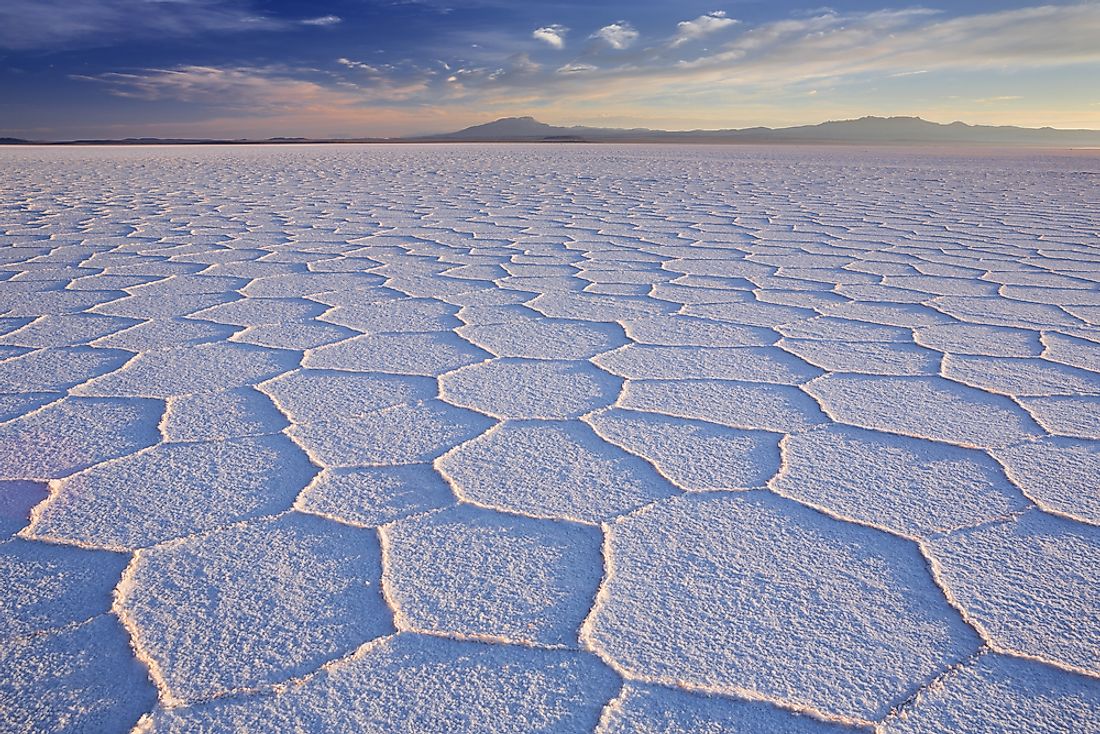Salar de Uyuni, Bolivia – The Largest Salt Flat on the Planet

Nestled in the high plateaus of the Andes Mountains in Bolivia stretch the blindingly bright white plains of the Salar de Uyuni, the largest salt flat in the world. This phenomenon was created 40 thousand years ago, when Lago (lake) Minchin, a giant lake that covered most of southwest Bolivia, dried up, leaving two smaller lakes and two major salt deserts. Covering over 4,600 square miles and nearly 33 feet in depth, the Salar de Uyuni is also the world’s highest desert at almost 12,000 feet above sea level. One of South America’s most awe-inspiring sights, the area contains about ten billion tons of salt. The Salar de Uyuni is also home to sixty percent of the world’s lithium preserves, a mineral commodity used in the production of batteries and various pharmaceuticals. Considering its size, the salt mining endeavors at Salar de Uyuni are relatively meager, though plans for future mining of lithium and other minerals are being considered by Bolivian officials.
4. Tourism
There are many sights to take in at the Salar de Uyuni. Depending upon the time of year, a visit will allow for varying perspectives of the landscape. During the dry season, which lasts from May through October, the surface of the plains hardens, and begins to form geometric figures of salt particles. With the bright plains of white stretching as far as the eye can see, Salar de Uyuni is also sprinkled with many "islands" including La Isla del Pescadoro (Fish Isle—so named for its shape), which is the largest of these islands, with its thousand-year-old giant cacti and rock formations of petrified coral, which in fact are the only signs of life for miles. During the wet season from November through March, there is a shallow layer of water that sits upon the surface of the Salar de Uyuni, which becomes a giant mirror that reflects the sky causing varying optical illusions. Temperatures peak at 70oF from November to January, and are lowest at 55oF in June. Nights are always colder than daytime temperatures in the Salar de Uyuni, and vary from 16 to 41 degrees Fahrenheit depending upon the time of year. Tours to the Salar de Uyuni can be booked from the nearby town of Uyuni, which is a mere 45-minute drive from the salt flats. Uyuni itself is itself separated from Bolivia’s capital, La Paz, by a one-hour flight.
3. Uniqueness
Being the largest salt flat in the world has caused for inspiration to arise in its visitors, and it earns a place on any globetrotter’s “must see” list. In fact, many may not know that there is a hotel on the Salar de Uyuni that is made completely out of salt. The expanse of salt here, which stretches for over 4,600 square miles, stands alone in the natural world. The mirages caused by solar radiation and the crystalized ground can be mesmerizing, as can the mirrored images reflected from the sitting water during the rainy season. The unique flora and fauna also make the area worth one's visit.
2. Habitat
For the most part, the salt flats are devoid of life. However, sitting in the middle of the Salar de Uyuni are several islands that serve as the only signs of life, themselves serving as homes to various flora and fauna for thousands of miles. Highlights of a few of the larger islands include thousand-year-old cacti. Among the creatures that wander the islands are three species of flamingos, rare hummingbirds and many other bird species, viscachas (rodents that look like rabbits with long tails), culpeos (Andean foxes), and Andes geese. Come each November, Salar de Uyuni is a breeding ground for the pink flamingos, which is truly an unforgettable sight for those who behold it.
1. Threats
Although there is plenty of salt to be mined (10 billion tons), less than 25,000 tons per year are actually mined, which is not an extensive enough of an operation to significantly threaten any of the wildlife living upon the few inhabited islands in the Salar de Uyuni. The only real danger is incompetent tour operators, who may have and use unsafe equipment, including motor vehicle. Fatalities have even been caused by such faulty equipment. To avoid a negative experience, make certain that the tour company you have chosen while visiting Salar de Uyuni has well-maintained vehicles, with effective seatbelts, radio transmitters, and first-aid equipment.











